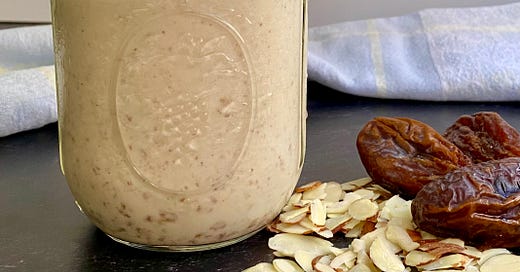The Breakfast Upgrade That Could Make a Big Difference: More Protein
+ Almond Tahini Date Smoothie recipe
Although I wince a little each time I see another protein-pushing social media post or protein-enhanced product at the store, and I’d rather not add to the firehose of protein content, I can’t let my feelings get in the way of the facts. The truth is, most of us would benefit from getting more protein at breakfast. I am so convinced of this that I have made it my personal wellness goal for the New Year, so I just had to dedicate this first newsletter of 2025 to tell you about it.
As I wrote in How Much Protein Do You Really Need?, the vast majority of Americans get plenty of the macronutrient overall, and eating more than enough is not necessarily better and could be harmful. Where most of us could benefit is by changing when we eat our protein. We tend to get most of it at dinner time, but research shows that distributing it more evenly throughout the day could be a real gamechanger for long term health.
Thanks for reading Ellie’s Real Good Food! This issue is for paid subscribers with a sneak peek for free subscribers. I hope you will consider upgrading to paid to get the full archive of articles, exclusive recipes, and more. I appreciate your support of this work — free or paid, I’m grateful for you!
Why More Protein at Breakfast Matters
As we age our bodies become less efficient at building and maintaining muscle. Starting at about age 30 we begin to lose roughly 1% of our muscle mass each year. That can add up to a loss of 50% of our muscle by the time we are in our 80s, which can have real consequences in terms of our ability to live independently.
Distributing protein more evenly throughout the day can help stem that tide. Research shows that eating a minimum of 25-30 grams of protein at a meal can help stimulate muscle building in older people. So does exercise, especially resistance exercise. The two together can help us maintain our precious muscle as we age.
Getting that much protein at lunch or dinner is generally not a push. A palm-sized piece of chicken or fish, or a bowl of lentil soup and a hunk of bread will get you there. It’s breakfast that can be more challenging because it means starting your day with a more substantial meal than you are likely used to.
What If You’re Not Hungry for Breakfast?
Many people say they are just not hungry first thing in the morning. If you don’t have an appetite right after getting up, it’s OK to wait a couple of hours before eating ---it still counts as breakfast.
Also, eating a lot in the evenings, including snacking after dinner, could be squashing your appetite in the morning. Try shifting your eating pattern so you have a very light snack in the evening, or skip nighttime snacks altogether. You’ll likely find yourself getting hungry earlier in the day.
High Protein Breakfast Ideas
Keep reading with a 7-day free trial
Subscribe to Ellie's Real Good Food to keep reading this post and get 7 days of free access to the full post archives.



